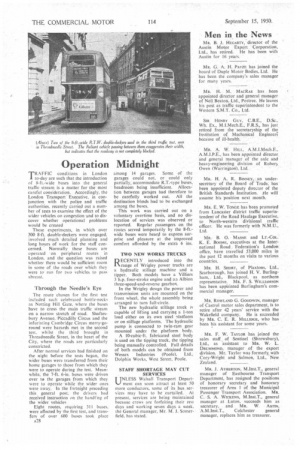Operation Midnight
Page 30

If you've noticed an error in this article please click here to report it so we can fix it.
TRAFFIC conditions in London
to-day are such that the introduction of 8-ft.-wide buses into the general traffic stream is a matter for the most careful consideration. Accordingly, the London Transport Executive, in conjunction with the police and traffic authorities, recently carried out a number of tests to examine the effect of the wider vehicles on congestion and to discover whether operational problems would be created
These experiments, in which over 300 8-ft. double-deckers were engaged, involved much detailed planning and long hours of work for the staff concerned. Normally these buses are operated on peripheral routes in London. and the question was raised whether there would be sufficient room in some of the roads over which they were to run for two vehicles to pass abreast.
Through the Needle's Eye
The route chosen for the first test included such celebrated bottle-necks as !Notting Hill Gate, where the buses have to cross the main traffic stream on a narrow stretch of road. Shaftesbury Avenue. Piccadilly Circus and the infuriating Cambridge Circus merry-goround were hazards met in the second test, whilst the third brought in Threadneedle Street. in the heart of the City, where the roads are particularly constricted.
After normal services had finished on the night before the tests began, the wider buses were transferred from their home garages to those from which they were to operate during the test. Meanwhile, the 7-ft. 6-in, buses were driven over la the garages from which they were to operate while the wider ones were away. In the fortnight preceding this general post, the drivers had received instruction on the handing of the wider vehicles Eight routes, requiring 311 buses. were affected by the first test, and transfers of over 600 buses took place A28 among 14 garages. Some of the garages could not, or could only partially, accommodate R,T.-type buses, headroom being insufficient. Allocation between garages had therefore to be carefully worked out. All the destination blinds had to be exchanged among the buses.
This work was carried out on a voluntary overtime basis, and no dislocation of services was observed or reported. Regular passengers on the routes served temporarily by the 8-ft.wide buses were heard to express surprise and pleasure at the improved comfort afforded by the extra 6 ins.
TWO NEW WORKS TRUCKS RECENTLY introduced into the range of Wrigley power trucks are a hydraulic stillage machine and a tipper. Both models have a Villiers 3 h.p. four-stroke engine and an Albion three-speed-and-reverse gearbox.
In the Wrigley design the power and transmission units are mounted on the front wheel, the whole assembly being arranged to turn full-circle.
The new hydraulic stillage truck is capable of lifting and carrying a 1-ton load either on its own steel nlatform or on stillage platforms. The hydraulic pump is connected to twin-ram gear mounted under the platform body.
A 10-cubic-ft. fabricated steel body is used on the tipping truck, the tipping being manually controlled. Full details of both models can be obtained from Wessex Industries (Poole). Ltd., Dolphin Works. West Street, Poole,
STAFF SHORTAGE MAY CUT SERVICES
INLESS Walsall Transport Department can soon attract at least 50 more conductors, some of its bus services may have to be curtailed. At present, services are being maintained because crews arc forfeiting their rest days and working seven days a week. the General manager. Mr. M. J. Somerfield, has stated.




































































































